Join More Than 50,000+ Subscribers and get latest camera news and rumors
NEW CAMERA VIDEOS ON YOUTUBE
|
By admin, on October 30th, 2013
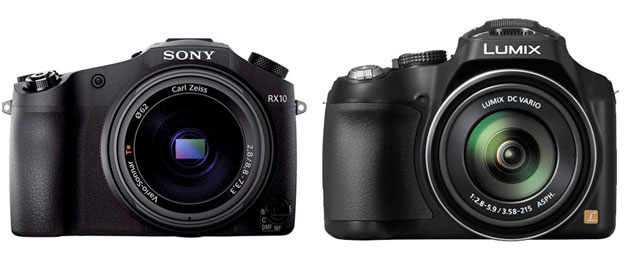 Sony RX10 features same sensor as Sony RX100 M2 camera on the other hand Fujifilm FZ70 features 16.1MP 1/2.3″ BSI MOS Sensor. Sony RX10 features same sensor as Sony RX100 M2 camera on the other hand Fujifilm FZ70 features 16.1MP 1/2.3″ BSI MOS Sensor.
 Take a look at the major difference below we found between RX10 and FZ70 Take a look at the major difference below we found between RX10 and FZ70
#1 Big difference between the Zoom Lens – The Panasonic FZ70 features Lumix DC Vario 60x optical zoom lens, the RX10 is limited to 8.3X only. So if you are a megazoon camera lover don’t read more and Buy Panasonic FZ70 from Amazon.
# 2 Big difference between the Sensor Size: Sony RX10 features a 20.2MP 1″ Exmor R CMOS Sensor and Panasonic FZ70 comes with 16.1 megapixel 1/2.3″ High Sensitivity MOS sensor, frankly speaking Sony RX10 comes with monster size sensor when compared Panasonic FZ70.
Sony RX10 Will give you better image quality, more dynamic range and less noise at High ISO levels, If you prefer image quality over zoom, RX10 is highly recommended.
#3 Fixed Aperture Zoom Lens – Sony RX10 features fixed F2.8 aperture throughout the zoom range, Carl Zeiss Vario-Sonnar T* lens is composed of 7 aspheric elements and delivers super sharp images.
# 4 You get better ISO range with RX10 – Rx10 offers better ISO range than FZ70, the 1″ inch sensor of RX10 comes with newly developed Bionz X processor to deliver ultimate image quality.
#5 Rugged design – compact magnesium alloy body of the RX-10 is moisture and dust resistant.
#6 Other features: You get bit more shutter range and top shooting continuous , WiFi – sharing with social networking sites, via email, and to cloud storage sites. NFC (Near Field Communication) is also supported with RX10.
# 7 Big Price Difference – Sony RX10 Price – $1,298.00 (Available at Amazon) | FZ70 Price – $398.00 (Available at Amazon)
Verdict: Sony RX10 will give best of its class image quality like no other, Panasonic FZ70 offers extensive zoom range + There is very big price difference between these two camera, if you prefer image quality buy RX10, if you want extensive zoom range buy FZ70.
By admin, on October 29th, 2013
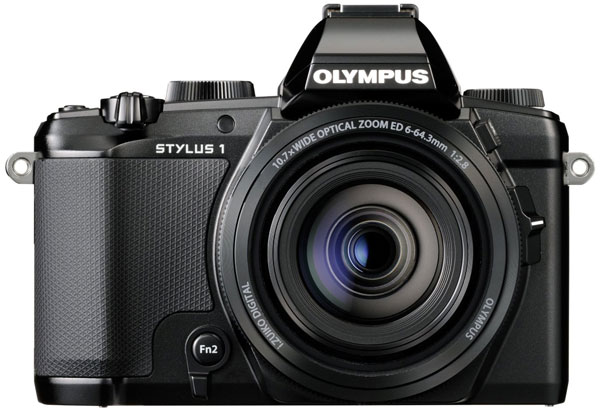 Olympus Stylus 1 finally announced today, the camera features 12 MP 1/1.7″ back-side illuminated CMOS sensor, 10.7x optical zoom lens with an f/2.8 constant aperture, ISO range from 100-12800, on the rear side we have 1.44 million-dots resolution EVF and 3.0″ tilt-touch LCD screen has a resolution of 1.04 million dots. Take a look at the major specification below Olympus Stylus 1 finally announced today, the camera features 12 MP 1/1.7″ back-side illuminated CMOS sensor, 10.7x optical zoom lens with an f/2.8 constant aperture, ISO range from 100-12800, on the rear side we have 1.44 million-dots resolution EVF and 3.0″ tilt-touch LCD screen has a resolution of 1.04 million dots. Take a look at the major specification below
Olympus Stylus 1 Major Features
- 12MP 1/1.7″ BSI CMOS Sensor
- 10.7x i.Zuiko Optical Zoom Lens
- 28-300mm Equiv; f/2.8 Constant Aperture
- Super Macro Mode with 2″ Minimum Focus
- 1.4M-dot High-Def EVF with Eye Sensor
- 3.0″ 1.04M-dot Tilt-Touch LCD
- Full 1080p HD Video
- Built-in Wi-Fi Connectivity
- Hybrid Control Ring and Auto Lens Cap
- Built-in Flash, Wireless, Hot Shoe
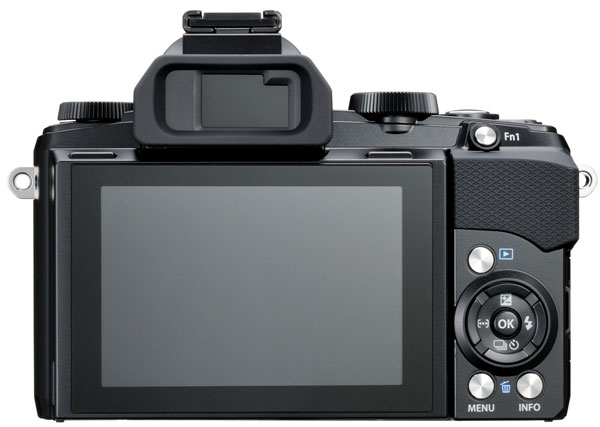 Full HD 1080p at 30 fps is supported by the Stylus 1, other features include Built-in Wi-Fi Connectivity, Hybrid Control Ring enables zooming, manual focus and adjustment of aperture, shutter speed and more manually. Full HD 1080p at 30 fps is supported by the Stylus 1, other features include Built-in Wi-Fi Connectivity, Hybrid Control Ring enables zooming, manual focus and adjustment of aperture, shutter speed and more manually.
Olympus Stylus 1 Price – $699.00
Buy / Pre-order Olympus Stylus 1 from Amazon
Buy / Pre-order Olympus Stylus 1 From B&H
Press Release
Olympus Imaging Corporation (President: Haruo Ogawa) is pleased to announce the upcoming release of the OLYMPUS STYLUS 1, scheduled to go on sale in late November 2013. This model boasts an optical 10.7x (28-300mm*1), constant aperture f2.8, large-diameter, high-performance iZUIKO DIGITAL lens, and offer the DSLR-level image quality and functionality into a compact, slim camera body.
Pricing and Launch Date
| Category |
Product Name |
MSRP |
Launch Date |
| Compact digital camera |
OLYMPUS STYLUS 1 (Black) |
Open Price |
Late November 2013 |
Main Features
- An optical 10.7x (28-300mm*1), constant aperture f2.8 i.ZUIKO DIGITAL zoom lens packed into a compact, slim body.
- Equipped with a built-in large-size, high-image quality, high-resolution EVF for checking versatile shooting conditions.
- Shooting style of enhanced operability and stability inherited from OM-D, and a premium compact, slim design
- Full-featured controls and customization let users focus on shooting
- Built-in Wi-Fi*2 for easy image sharing and wireless shooting
| *1 |
35mm equivalent |
| *2 |
Wi-Fi is a registered trademark of Wi-Fi Alliance. |
The compact digital camera market is currently shrinking across the world, however, among these conditions, models with a large-format imaging sensor, bright lens, premium high image quality and performance, and models with a high magnification which cover a wide range of shooting conditions, remain their popularity.
Since announcing the XZ-1 in January 2011, Olympus has released the STYLUS-XZ-2 and the STYLUS XZ-10 equipped with i.ZUIKO DIGITAL lenses that feature excellent image quality and brightness to the telephoto end, resulted in leading the high-performance model market. All-in-one cameras that support various scenes with powerful zooms have also proved to be popular among families for shooting vacations and children’s events. However, up to now it has been difficult to create a model with a powerful zoom lens that effectively balanced the size, excellent image quality, and brightness at all focal lengths.
The new OLYMPUS STYLUS 1 is equipped with a newly-developed powerful i.ZUIKO DIGITAL lens that features a compact size, excellent image quality, and brightness at all focal lengths. Many powerful zoom models face the problem of subject blur that occurs in telephoto shooting in dark locations. This revolutionary lens significantly reduces subject blur without degrading image quality. The STYLUS 1 is the flagship model of the STYLUS series, achieving excellent image quality and a high zoom factor through the fusion of an i.ZUIKO DIGITAL lens, and the shooting style of the Olympus Mirrorless Interchangeable-Lens flagship model, the OM-D. The best functions from larger, heavier, and more expensive DSLR cameras with the similar specs have been packed into a compact, slim body.
i.ZUIKO DIGITAL lens of the STYLUS 1 covers a focal distance of 28 to 300mm at 10.7x (35mm equivalent), with a rarely-seen, bright constant aperture f2.8. The brightness of the lens is available at all focal lengths, and promises excellent image quality and defocusing effects from macro shooting to telephoto shooting, with performance that departs from traditional compact cameras. Also, all types of aberrations that occur in powerful zoom cameras are almost perfectly corrected at all focal lengths.
This camera is equipped with a large-size electronic viewfinder (EVF) with the largest magnification factor in class for a compact camera that is equal in quality to the Mirrorless Interchangeable-Lens camera, OM-D, where users can watch varied shooting conditions change in real time in the viewfinder. Stable shooting style while looking into the EVF, full-featured performance, and design that extends to every detail of the slim body make authentic, OM-D-inherited shooting possible. When the automatic opening lens cap is attached, the time from turning the power on to shooting is shortened, and because only the faintest sound from the lens shutter can be heard, the STYLUS 1 delivers a new experience in quiet shooting.
We also focused on the controls of STYLUS 1. In addition to using the Hybrid Control Ring made popular on the STYLUS XZ-2, the zoom lever and customization of all buttons ensure that users never miss a photo opportunity, for authentic shooting that is equal to DSLR cameras.
The STYLUS 1 is the flagship model of the STYLUS series, packing DSLR-level excellent image quality, powerful magnification, superior functions, and a wide shooting range into a compact body for an authentic shooting experience that anyone can easily enjoy – from beginners to advanced users.
Main Features Details
1. An optical 10.7x (28-300mm*1), constant aperture f2.8 i.ZUIKO DIGITAL zoom lens packed into a compact, slim body
1) Constant aperture f2.8, powerful zoom lens for those who enjoy creative shooting
This 10.7x zoom lens boasts a maximum aperture value of f2.8 that is bright in all focal length, and covers from 28 to 300mm (35mm equivalent). In particular, the beautiful defocusing effects produced by the f2.8 at a 300mm equivalent telephoto setting overturns conventional wisdom about compact cameras, making it possible to capture photos where subjects seem to float off the image. Additionally, the brightness of the lens makes it possible to lower the ISO speed, which is beneficial to image quality.
Because the aperture value is fixed to f2.8 even when zooming, control of exposure in Aperture priority (A) mode is easy. Also, because the shutter speed can be increased, subject blur that tends to occur in dim-lit shooting scenes can be reduced. The brightness across all focal length, and fixed large aperture make this a masterpiece of a lens, fulfilling the highest demands for professionals in a zoom lens.
2) Optical design and coating that support excellent image quality
i.ZUIKO DIGITAL lens of the STYLUS 1 was developed based on the DSLR interchangeable ZUIKO DIGITAL lens series, for sharp, next-generation depictive performance from the center to the edges of the image. Olympus molding technology cultivated with DSLR interchangeable lenses was freely used to create a DSA (Dual Super Aspherical) lens for use as an aspherical element in the lens group. A total of 9 aspherical lenses are used in the 12 element, 10 group lens construction. This construction not only effectively compensates for all types of aberration in all zoom range, but allows the lens barrel to be stored in the 52mm deep body when retracted. In order to remove ghosts and flaring, the Olympus-original ZERO (Zuiko Extra-low Reflection Optical) coating was applied to the surface of the lens. These measures ensure highly clear depictive performance, even in backlit or other unfavorable shooting conditions.
3) Powerful macro shooting function
At a 300mm equivalent telephoto setting the minimum shooting distance from the end of the lens is 80cm, making tele-macro defocusing effects possible. With Super Macro, close-up shooting from 5cm away from the end of the lens is available.
4) Powerful image stabilization
Lens shift-type image stabilization is used on the STYLUS 1. This method enables a compact camera construction, and reduces camera shake that tends to occur at telephoto settings or when shooting in dark locations.
5) Automatic Lens Cap attached
A removable lens cap that automatically opens when the power is turned on is supplied with the camera so that users can rest easy, knowing that they will always be able to capture the moment.
2. Equipped with a built-in large-size, high-image quality, high-resolution EVF for checking versatile shooting conditions
1) Performance that exceeds entry-level DSLR cameras
The STYLUS 1 is equipped with a built-in EVF equal to the Olympus Mirrorless interchangeable lens camera, OM-D E-M5. The beauty of the 1.44 million dots, high-resolution LCD is without compare when measured against previous compact digital cameras or home-use camcorders. With field coverage of 100%, it outperforms field coverage of entry-level DSLR cameras. With clear visibility from the center to the edges, users can check the exposure, color, and focus peaks before shooting.
2) Fast response and eye sensor functions
Viewfinder shooting is stress free, thanks to the fast response and short display time lag. Also, with the eye sensor function, simply looking into the viewfinder automatically switches the display from the rear monitor to the viewfinder. The eye sensor is automatically turned off when the rear monitor is tilted or the playback menu is being used to prevent misoperation and improve usability.
3) Adaptive Brightness Technology
This feature raises the brightness of backlight when shooting in bright outdoor conditions, and lowers the brightness in dark indoor conditions, reducing visual errors from light and dark adaptation of the eye. The backlight brightness is automatically adjusted in accordance with ambient light to maintain the proper brightness providing a natural appearance that is close to that of optical viewfinders (OVF).
4) Electronic level gauge and highlight & shadow display
This feature provides functions unavailable on optical viewfinders, and is useful for checking the electronic level gauge while looking at subject (previous display and 3D display), as well as displaying highlights and shadows for finishing photos with a touch of distortion or just the right exposure.
3. Shooting style of enhanced operability and stability inherited from OM-D, and a premium compact, slim design
As the flagship of the STYLUS brand, the STYLUS 1 neither function nor design were compromised, with attention down to the smallest details. The excellent control and stability of OM-D-inherited shooting style provides ease of use as a DSLR sub model.
The highly-stable grip, even when shooting at a 300mm*1 equivalent, lets users firmly hold the camera for long periods of time without tiring. The entire control scheme is designed around the right grip hand, including the zoom lever and Hybrid Control Ring so that a stable DSLR shooting style is possible while looking through the electronic viewfinder.
A compact, slim body design was achieved with a pentaprism silhouette while including a viewfinder and built-in flash. When an interchangeable lens with an equivalent focal length of 28 to 300mm is attached to a DSLR or Mirrorless interchangeable-lens camera, they become large and heavy, but the STYLUS 1 achieves the similar outstanding performance in a compact, slim body design. This camera can be carried around in a bag for easy and fun shooting with the authentic operation of a DSLR sub model. The camera has a premium black finish.
4. Full-featured controls and customization let users focus on shooting
The STYLUS 1 maintains its comfortable controls while providing customization to match users’ shooting style for an intuitive approach to shooting exactly as photos are envisioned.
1) Hybrid Control Ring
This model is equipped with the STYLUS XZ-2’s popular Hybrid Control Ring. Because frequently used functions can be assigned to the Hybrid Control Ring, settings such as the aperture value or exposure compensation can be quickly adjusted with a twist of the ring, letting users capture images exactly the way they want without missing a chance of shooting. Using the Control Lever located next to the lens, two control types (analog and digital) can be switched immediately.
2) Subdial
The subdial which can be controlled with the thumb of the right hand is equipped for the first time on an Olympus compact digital camera. This feature lets users grip the camera with their right hand and change all pre-assigned settings with minimal movement. In combination with the Control Ring, numerous settings can be changed quickly.
3) Two selectable zoom levers
On compact digital cameras, the zoom lever is normally located on the top of the camera. In addition to the usual location, the STYLUS 1 includes a zoom lever on the left hand side of the lens. With this innovation, the camera can be supported with the left hand for DSLR-style zoom operations, allowing users to focus on the release button with the right index finger so that photo opportunities are never missed. The left hand zoom lever can also be used to adjust the zoom slowly for fine adjustments when composing a shot.
4) Rich customization functions
Users can assign frequently used functions to the Fn1 button and movie button for quick activation. Also, each time the Fn2 button is pressed, multiple functions can be switched, and when the function is activated it can be set to the Hybrid Control Ring or Sub-dial to be used. Two different custom modes are available on the mode dial. Users’ favorite pre-assigned settings can be activated simply by turning the dial.
5. Built-in Wi-Fi*2 for easy image sharing and wireless shooting
The STYLUS 1 is equipped with a built-in Wi-Fi function which enables easy connection to a smartphone simply by touching the Wi-Fi icon. The OLYMPUS Image Share (OI.Share)*3 smartphone app can be used to easily send images to a smartphone.
With the OI.Share remote control function, the camera’s Live View screen can be viewed on a smartphone while remote shooting in P, A, S, M, and iAUTO modes for smooth operations and zoom operations is also available. By touching the Live View screen that appears on the smartphone AF points can be specified and the shutter can be activated with the same controls as on the camera. Also, users need only to transfer highly-precise GPS logs obtained with OI.Share to the camera to easily add geotags (location information) to images taken with the camera.
Using OI.Share’s simple connection function, troublesome initial settings can be easily completed simply by scanning the QR code that appears on the camera screen.
Other Features
iHS Technology
iHS stands for “intelligence”, “high-speed”, and “high-sensitivity”. With the combination of a 1/1.7 type, 12.0 megapixel*4, back-lit CMOS sensor (BSI CMOS sensor), and the TruePic image processor designed for the OLYMPUS PEN, focusing speed is improved, and users will always be able to capture the subject they want, beautifully, and without missing. Additionally, the STYLUS 1 inherits FAST AF from the OLYMPUS PEN series and Touch AF Shutter allows users to instantly shoot exactly the way they want by simply touching the screen, regardless of the subject’s position.
PHOTO STORY
The STYLUS 1 includes an advanced version of PHOTO STORY, made popular on the STYLUS XZ-10. Shoot and select moments from various viewpoint by simply touching on the Live View screen. It offers 2 themes; “Standard” which has a variation of choices including patterns, effects, aspect ratios, and the number of images, and “Fun Frames” with three variations of stylish shot. With these features, everyday life will become memorable scenes with varied personalities.
Art Filters
The 11 Art Filters and 5 Art Effects*5 will fuel the spark of imagination so that users can create more stand-out pictures that match their imaginations exactly. Art Filter effects are available for still images, but they can also be used when shooting Full HD movies for greater freedom of expression and enjoyment. Art Filter Bracketing can help out users who have trouble deciding on which Filter to use by automatically applying multiple Art Filters and playing the images back in a slide show. This feature turns mediocre scenes into a virtual kaleidoscope of enjoyment, providing new discoveries in everyday scenery through unexpected filter effects. Additionally, Art Filter Bracketing can be applied when editing RAW images.
Digital Tele-converter
By enlarging 2x in the center of image, digital tele-converter function can be used. By applying this function to the Fn button, this function can be used by simply touching the button. With the superior performance of TruePic image processor, it enables to shoot up to 600mm F2.8*1 while retaining excellent image quality. With the tele-converter lens TCON-17X, it can shoot up to approx. 1020mm F2.8*1.
- Advanced iAUTO which automatically detects scene settings
- High-sensitivity shooting at ISO 12800 which reduces blurring and maintains excellent image quality
- Equipped with an ND filter for controlling exposure in 3 steps, for beautifully defocused shots even in bright locations
- The Bulb function enables up to 30 minute of shooting
- The Custom Self function offering customizable options such as the number of shots, self timer time, and shooting interval
- Equipped with a tilting 3.0 type, 1.04 million dots capacitive touch panel
- Zoom Framing Assist function helping users to recapture subjects lost during telephoto shooting, by reducing to half the zoom factor with the push of a single button so they can be found again
- Built-in flash
- i-Enhance mode is equipped on the STYLUS 1 for the first time on any compact camera, enabling automatic detection of subjects and optimal color and contrast reproduction
- Supported media: memory cards, (SD, SDHC, SDXC, UHS-I compatible), Eye-Fi cards
| *3 |
Compatible with iOS and Android |
| *4 |
Effective pixels |
| *5 |
Art Effects and frames that can be applied differ depending on each Art Filter |
Olympus Stylus 1 Full Specification
| Image sensor |
Type |
1/1.7 type CMOS sensor |
| Number of pixels |
12 million pixels (camera effective pixels) |
| Lens |
Construction |
12 elements in 10 groups (Including 9 aspherical lenses) |
| Focal length |
6.0mm – 64.2mm (35mm equivalent: 28mm – 300mm) |
| Maximum aperture value |
2.8 |
| Zoom |
Optical zoom: 10.7x
Digital Tele-converter: 2x (21.4x in combination with the optical zoom) |
| Shooting range (from the end of the lens) |
Normal: 10 cm – infinity (W), 80 cm – infinity (T)
Super Macro: 5cm – 60cm (fixed focal length) |
| Image recording |
Recording format |
DCF, DPOF compliant, Exif compatible, PRINT Image Matching III |
| Recording image type |
RAW, JPEG, RAW+JPEG |
| Number of recording pixels |
RAW: 3968 x 2976, JPEG:3968 x 2976 – 640 x 480 |
| Movie recording |
Recording format |
Full HD/HD: MOV (MPEG-4AVC/H.264)
HS: Motion JPG
– Except for some Art Filters |
| Number of recording pixels |
Full HD: 1920 x 1080, Aspect ratio: 16:9, 30p
Full HD: 1280 x 720, Aspect ratio: 16:9, 30p
HS120: 640 x 480, Aspect ratio: 4:3, 120p
HS240: 320 x 240, Aspect ratio: 4:3, 240p |
| Maximum recording time |
Full HD: approx. 29 min., HD: approx. 29 min., HS: 20 sec.
– Except for some Art Filters |
| Audio recording |
Audio recording format |
Conforms to WAVE format (Stereo linear PCM/16 bit, Sampling frequency: 48 kHz) |
| Maximum recording time |
Still images: Max. 30 sec., Movies: Depends on shooting time |
| Recording media |
Supported recording media |
Memory cards (SD, SDHC, SDXC, UHS-I compatible), Eye-Fi cards |
| Viewfinder |
Type |
Eye-level electronic viewfinder, approx. 1.44 million dots |
| Field of view / magnification |
Approx. 100%/
approx. 0.92x*1 to approx. 1.15x*2 (50mm lens/infinity/-1m-1)
*1 When using viewfinder style 1 or 2 (4:3)
*2 When using viewfinder style 3 (4:3) |
| Eyepoint / scope of dioptric adjustment |
Approx. 18 mm (at -1m-1)/approx. -4 to +2m-1 from the final lens surface |
| Preview |
Possible with the preview function button*
*Custom function |
| Line display |
Select from no lines, grid, golden section, gradation, diagonal |
| Electronic level gauge display |
2-axis (horizontal/vertical directions) level gauge |
| Brightness adjustment / color temperature adjustment |
Adjustment in ±7 steps/Adjustment in ±7 steps |
| Eye cup |
Can be exchanged for separately-sold Eye Cup EP-11 |
| Rear display |
Size, type / number of dots |
3.0 type tilting LCD monitor/Approx. 1.04 million dots, capacitive touch panel |
| Image stabilization |
Type |
Lens shift type image stabilization
– Electronic image stabilization when shooting movies |
| Focus |
AF type |
Imager AF mode |
| Focus mode |
Single AF, Super Macro, Continuous AF, AF Tracking, Manual |
| AF Illuminator |
Available |
| Exposure control |
Metering method |
Digital ESP, Center-weighted Average, Spot, Spot Highlight & Shadow Control |
| Exposure control method |
iAUTO, Program, Aperture Priority, Shutter Priority, Manual, Custom1, Custom 2, PHOTO STORY, Scene Select, Art Filter |
| Scene Select AE |
Portrait, ePortrait, Landscape, Sport, Night Scene, Night Scene & Portrait, Sunset, Documents, Panorama, Fireworks, Multi-Exposure, Beach & Snow |
| Sensitivity (Standard output sensitivity) |
Still images: Auto ISO 100 – 12800 (Customizable, Default settings: ISO 100 – 1600) Manual ISO 100 – 12800) |
| Exposure compensation range |
±3EV |
| White balance |
White balance mode |
Auto, Pre-setting (6 types), One Touch WB (register up to 2), Custom WB
– White Balance Compensation |
| Shutter |
Shutter speed |
1/2000 – 60 sec., Bulb (Max. 30 min.) |
| Self timer |
2 sec., 12 sec., custom |
| Drive |
Drive mode |
1 frame, Sequential shooting, BKT, Self-timer |
| Continuous shooting speed |
Approx. 7 fps |
| Maximum frame rate |
[RAW] Approx. 25 frames in continuous shooting),
[JPEG: LN] Approx 70 frames in continuous shooting)
(When TOSHIBA SDHC UHS-I card EXCERIATMTYPE1 32GB is used, under in-house testing) |
| Flash |
Flash mode |
Auto, Red-eye reduction, Fill In, Flash Off, Red-eye SLOW, SLOW, Manual (FULL, 1/1.3, 1/1.6, 1/2, 1/2.5, 1/3, 1/4, 1/5, 1/6, 1/8, 1/10, 1/13, 1/16, 1/20, 1/25, 1/32, 1/40, 1/50, 1/64, 1/80, 1/100, 1/128) |
| Shooting range |
W: 0.6 – 10.3 m*, T: 0.8 – 8.5 m*
*At ISO 1600 |
| Shooting functions |
AE bracket, ND filter (equivalent to 3 steps) |
| Art Filter |
Filter |
Pop Art, Soft Focus, Pale and Light Color, Light Tone, Grainy Film, Pin Hole, Diorama, Cross Process, Gentle Sepia, Dramatic Tone, Key Line |
| Art Effects |
Soft Focus Effect, Pin Hole Effect, White Edge Effect, Frame Effect, Star Light Effect |
| PHOTO STORY |
Type |
Standard (Type I, II, III, IV)
Fun Frames (Instant, Film, Stripe) |
| Multi Aspect |
4:3, 3:2, 16:9, 1:1 |
| Playback function |
Single image, information display, index display, magnified display, movie (with sound, fast forward, rewind, pause), rotate playback slide show, slideshow effect (3 types) |
| Menu language |
Language selection |
38 languages including Japanese and English |
| Input / output |
Computer interface |
USB2.0 Hi-Speed |
| TV interface |
HDMI output (HD/stereo), video output (SD/monaural) |
| USB / AV terminal |
Dedicated multi-connector (Video: NTSC/PAL can be selected) |
| HDMI terminal |
HDMI micro connector (Type D) |
| Batteries |
Rechargeable lithium ion battery BLS-5 |
| Number of possible shots (CIPA compliant) |
Approx. 410 |
| Size |
116.2mm x 87mm x 56.5mm (with lenscap, CIPA compliant – W x H x D, not including protrusions) |
| Weight |
Approx. 402g (CIPA compliant – including bundled rechargeable battery and memory card) |
| Bundled items |
Rechargeable lithium ion battery (BLS-5), Automatic Lens Cap (LC-51A), USB cable, shoulder strap, charger (BCS-5), AC cable, software CD-ROM, instruction manual |
By admin, on October 27th, 2013
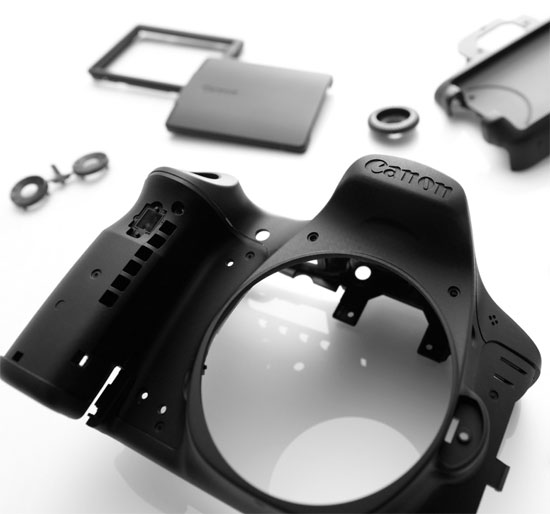
2012 was a bit dull year for Canon if we look at Sony, Fuji and Nikon products and we strongly hope that canon will recover from its slow move in 2014, I have created the list based on rumor I read daily in my mailbox and other websites worldwide, The list not only include those camera that we want to see, but the list contains the ones we believe that Canon need to get out as those models as soon as possible.
# 1 Canon 7D Mark II – The APS-C King
We know that Canon 7D suffered from a major firmware update last year but we also know that EOS 7D is now Canon’s oldest current DSLR waiting for its successor, I Still remember Canon 7D announced in September 2009 and it’s long overdue for a refresh. Take a look at the 7D Mk II rumored specification below
Rumored 7D Mark II Specification
20 OR 24 MP Dual Pixel CMOS AF Sensor
ISO 50-51200
61-Point High Density AF
Continuous shooting speed of 10-12 fps
Introduction of Dual Digic V+ in an APS-C body
Touch Display
Built in WiFi and GPS
Price around $2000
We already said that Canon will announce 7D Mk II on Q1 of 2014, probably on Feb or March 2014.
#2 APS-C fixed-lens compact
The time has come that Canon must announce a APS-C lens compact camera, If we look at competitors we have FujiX100S, Nikon coolpix A, Sony RX1R (FF Camera) and Ricoh GR…They are few step ahead from Canon.
We have seem a specification of Canon APS-C compact here, also see -> Canon large sensor compact surfaced over Canon France however later Canon france denied APS-C compact rumor.
- 18 MP APS-C sensor
- DIGIC 6 image processor
- 9 point Hybrid AF system
#3 Canon PowerShot G2 X
Canon 1.5 inch G1X look big and Bulky and almost 2 year old now + Canon users are buying Sony RX100, Nikon coolpix A, Fuji X100 / S and RX1 R as secondary camera. We hope that Canon will announce Its G2X replacement very soon.
#4 Canon Medium Format: We know that Canon is working on Medium Format camera and but they will not announce it until the new system is fully developed with Big bunch of High Quality Lenses, however the rumored date of new system announcement is Photokina 2014.
#5 Canon New Mirrorless Camera – EOS M II
Canon EOS M2 is almost ready, Canon is probably waiting to clear the stock of Canon EOS M camera, according to rumors 2 New EOS M is coming, the first one is a entry level mirrorless camera and seconf is a High-End mirrorless camera with advance features.
#6 Canon SX60 HS – High Zoom Camera
Canon SX 50HS is due for update and people are moving towards Panasonic FZ70 camera (60X zoom camera | also see SX50HS vs FZ70), we have high hopes and the next schedule announcement of Canon products is Feb and March 2013. See some rumors > Confirmed EOS M2 is Coming |
See more Canon Rumor
If you have some extra time – Also see
Nikon cameras we’d like to see in 2014
Sony cameras we’d like to see in 2014
By admin, on October 25th, 2013
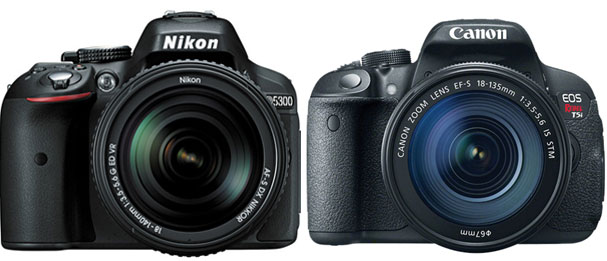 Nikon D5300 vs Canon 700D specification comparison review, Nikon D5300 features bit bigger sensor + More resolution compared to 700D / T5i, take a look at the detailed specification comparison review below. Nikon D5300 vs Canon 700D specification comparison review, Nikon D5300 features bit bigger sensor + More resolution compared to 700D / T5i, take a look at the detailed specification comparison review below.
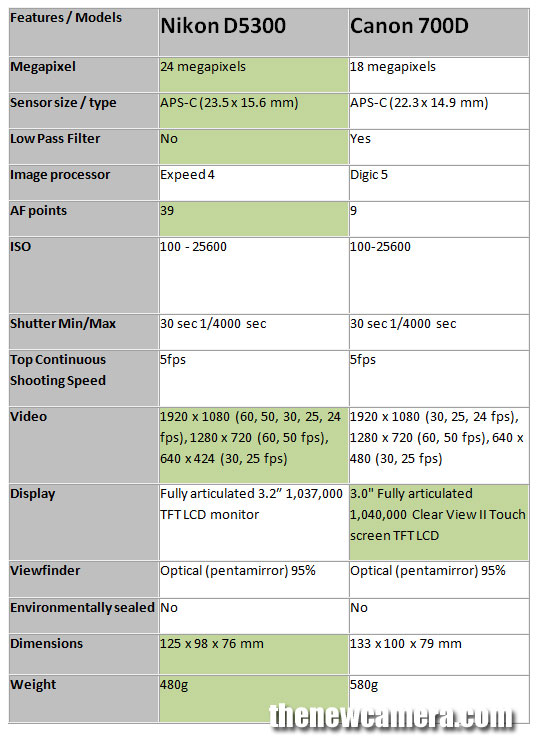
Take a look at the Major difference we found…
#1 Sensor: Nikon D5300 features 24.2 megapixel DX-format CMOS sensor same sensor as Nikon D7100 DSLR and we have seen the image quality of Nikon D7100 is excellent compared to 700D.
+ Nikon introduced a new Expeed 4 image processor with D5300, So D5300 features No optical Low-Pass filter + advance image processor compared to D7100, Nikon D5300 is a clear winner in-terms of image quality.
#2: No OPLF in D5300: The sensor design omits the traditional optical low-pass filter in order to gain the utmost sharpness and resolution from both photos and videos.
#3: AF System: Nikon D5300 features advance Phase AF system, Nikon D5300 have 39-point autofocus system, with nine cross-type sensors. Canon 700D comes with 9-point all cross-type AF system (including a high-precision dual-cross f/2.8 center point).
#4: Fast AF in Live-view & Video mode with 700D – Canon 700D newly developed Hybrid CMOS AF System is utilizes two different kinds of AF-phase and contrast detection technology, hence you get quick AF during live-view mode & in video mode, Nikon D5300 uses Contrast based AF system only in Video and live-view mode.
#5:Video: Nikon D5300 features Full HD recording @ 60fps on the other hand Canon 700D limited to 30fps at Full HD mode.

#6: Display: Canon 700D features better Touchscreen LCD with 1,040k-dot resolution, it also includes Touch Autofocus, Nikon D5300 comes with 3.2″ 1,037k-Dot Vari-Angle LCD Monitor.
# Others: Nikon D5300 features built-in Wi-Fi and GPS modules, Nikon D5300 features built in HDR capture that combines tonal and exposure range of a single image by recording two separate exposures and blending them together.
Verdict: Nikon D5300 core specification is better compared to 700D, Nikon D5300 gives you better image quality and advance Phase AF system, we recommend you to buy Nikon D5300 DSLR.
Buy / Pre-order Nikon D5300 from Amazon | B&H
Buy Canon 700D from Amazon US | Amazon UK
By admin, on October 24th, 2013
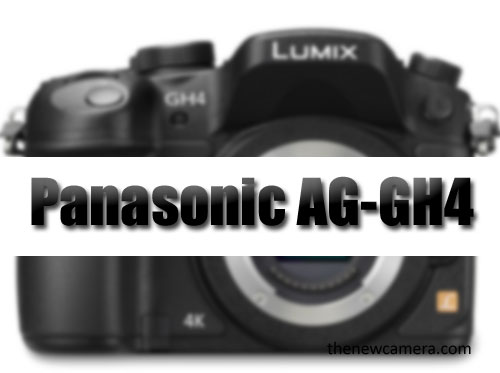 Panasonic GH series 4K Camera rumored specification surfaced over the web today , the camera name will probably AG-GH4, AG name comes from dedicated panasonic camcorder series (see AG series camera at B&H), the GH 4K will be a dedicated video camera no details about the still capability available yet… Panasonic GH series 4K Camera rumored specification surfaced over the web today , the camera name will probably AG-GH4, AG name comes from dedicated panasonic camcorder series (see AG series camera at B&H), the GH 4K will be a dedicated video camera no details about the still capability available yet…
Rumored specification Panasonic AG-GH4 Camera
- 4K/24/25/30fps
- 16mp sensor with full pixel readout
- 10bit 4:2:2 codec (likely AVC Ultra)
- 200Mbit MP4 ALL-I and 100Mbit IPB options
- Adapter that sits on the camera has 4x 3G-HD-SDI and 2x XLR
- Up to 30fps in 4K mode
- OLED monitor, 1 million dot
- 21mm OLED viewfinder, 3 million dot
- Form factor similar to the GH3 but slightly larger, all output jacks facing out of the left side
- Time code
The upcoming GH 4K camera will be not true replacement of current GH3 camera since it look more video oriented, however many GH3 users will upgrade to GH 4K .
Stay with at Facebook for more news and Panasonic Rumors
Recent camera from Panasonic – Panasonic GM1 Price, Press Release, Full Specification and Videos
src-EOSHD.com
By admin, on October 22nd, 2013
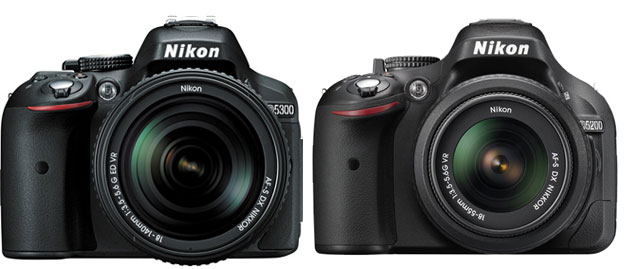
Nikon D5300 vs Nikon D5200 specification comparison, Nikon D5300 comes with new image processor, Nikon D7100 sensor and No optical low-pass filter OR AA filter. Take a look at the table below for detailed specification comparison.
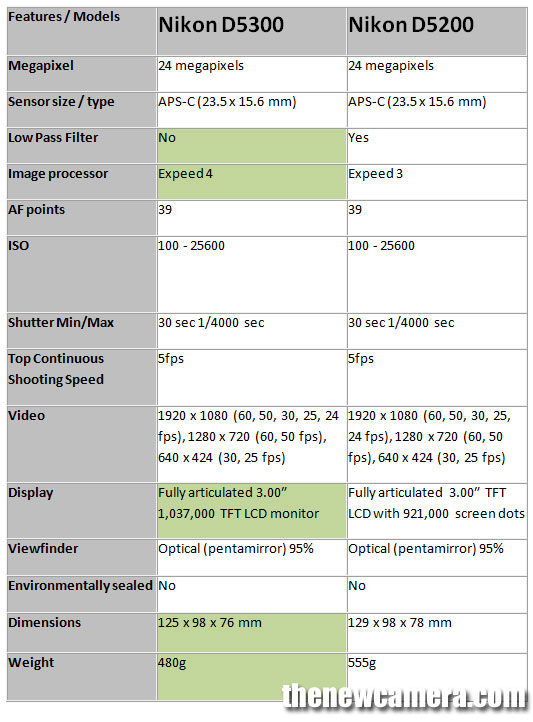
Nikon D5200 and D5300 features almost same core specification, take a look at the Major difference below,
#1:New Sensor: Nikon D5300 uses Nikon D7100 sensor, however there is now major difference in image quality when compared to Nikon D7100.
#2: No Optical Low-Pass Filter: Nikon D5300 Have no OPLF, hence you get more details when you use high-grade Nikon Lenses with D5300.
#3: New Expeed 4 processor: the new image processor is not improving the overall speed of the camera in any way or may be the processor have capabilities but bounded by software to do limited performance.
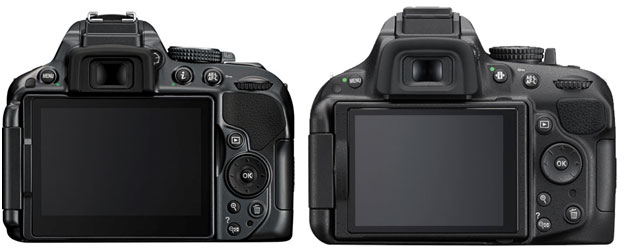
#4 Display: Nikon D5300 features more high resolution display compared to Nikon D5200.
#5: Built-In Wi-Fi and GPS Connectivity: Nikon D5300 features built in Wireless connectivity and GPS.
Verdict: We recommend Nikon D5100, Nikon D3100 and Nikon D3200 users to buy new Nikon D5300 DSLR, but we also recommend D5200 users to wait for Nikon D5400 (D5300 successor).
Buy / Pre-order Nikon D5300 from Amazon | B&H
By admin, on October 21st, 2013
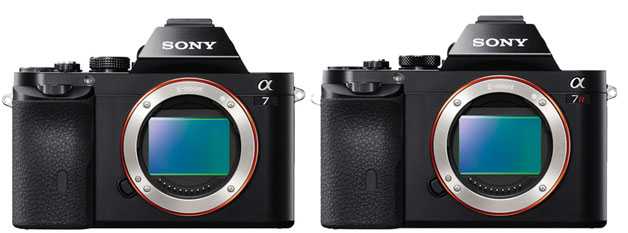 Sony A7 vs Sony A7r comparison review – Just few days ago Sony announced A7 and A7r fullframe mirrorless camera with excellent core specification, Sony is shaking the camera world from 2012 by announcing class leading innovative products like X series compact cameras, smartphone attachable lens-Style Camera and now FF Mirrorless. Sony A7 vs Sony A7r comparison review – Just few days ago Sony announced A7 and A7r fullframe mirrorless camera with excellent core specification, Sony is shaking the camera world from 2012 by announcing class leading innovative products like X series compact cameras, smartphone attachable lens-Style Camera and now FF Mirrorless.
Now take a look at the major specification difference in the table below
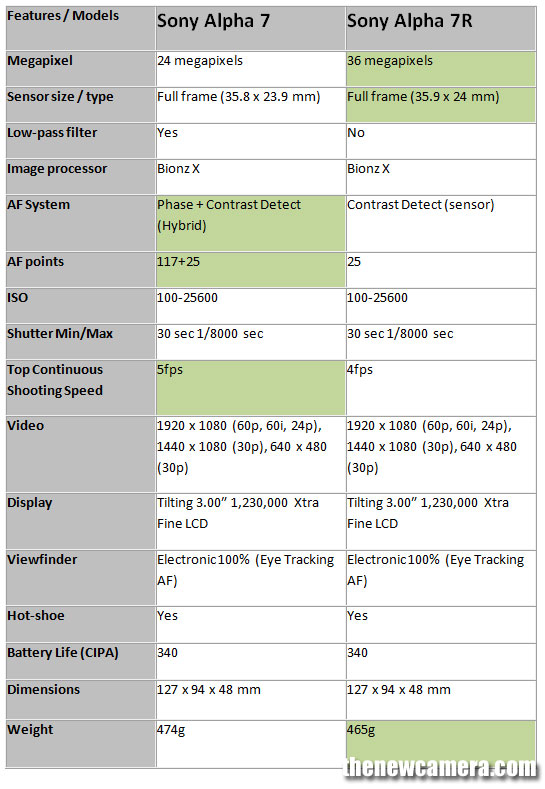
The Major difference we see in both the camera are
#1 Sensor
#2 AF System
#3 Electronic front curtain shutter in A7
#4 Fast top continuous shooting speed in A7
#5 Price difference
#1 Sensor: The Sony A7 features 24 Megapixel FF sensor and on the other hand Sony A7r features 36 Megapixel FF sensor, Obviously the sensor of A7 will give cleaner result at high ISO range due to larger pixels / photodiode inside it.
#2 AF system: as we have said earlier Sony A7 features Hybrid AF system that combines Phase + Contrast detect system, 117 phase AF points + 25 contrast detect AF points available in A7, on the other hand Sony A7r features Contrast detect system with 25 AF points only, naturally AF system of A7 is fast compared to A7.
#3 electronic front curtain shutter in A7: The A7 comes with electronic front curtain shutter, so you get (better) 1/250 flash sync speed with A7 on the other side A7R is limited to 1/160.
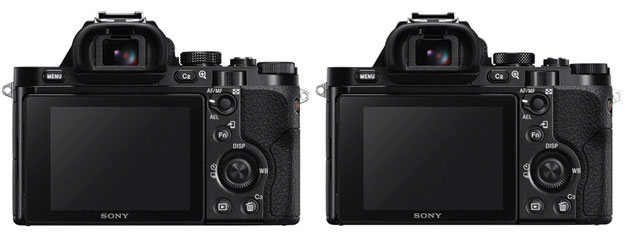 #4 Fast top continuous shooting speed in A7: Due to less resolution in A7 the image processor is able to process more files at a given time compared to A7r. #4 Fast top continuous shooting speed in A7: Due to less resolution in A7 the image processor is able to process more files at a given time compared to A7r.
#5 Price: Sony A7 cost $600 less than Sony A7r.
Verdict: We recommend you to buy Sony A7, since A7 features better AF system, better low-light performance, Electronic front curtain shutter, bit Fast continuous shooting speed and $600 approx less price, A7r only recommended for Landscape, Architecture and Fashion photographers, those who have more control over light and don’t need fast AF system.
Buying Options
Sony A7 [Body Only] – $1,698.00 – Amazon | B&H
Sony A7 w/ 28-70mm lens – $1,998.00 – Amazon | B&H
Sony A7r @ $2,298.00 from Amazon | B&H
|
KEEP THIS BLOG ALIVE - Support New Camera Buy Canon Lenses, Buy Music CD or Digital Camera at amazon it helps this site, and you do not pay anything extra, it is just a way to help support this site.

|
 Sony RX10 features same sensor as Sony RX100 M2 camera on the other hand Fujifilm FZ70 features 16.1MP 1/2.3″ BSI MOS Sensor.
Sony RX10 features same sensor as Sony RX100 M2 camera on the other hand Fujifilm FZ70 features 16.1MP 1/2.3″ BSI MOS Sensor. Take a look at the major difference below we found between RX10 and FZ70
Take a look at the major difference below we found between RX10 and FZ70

















